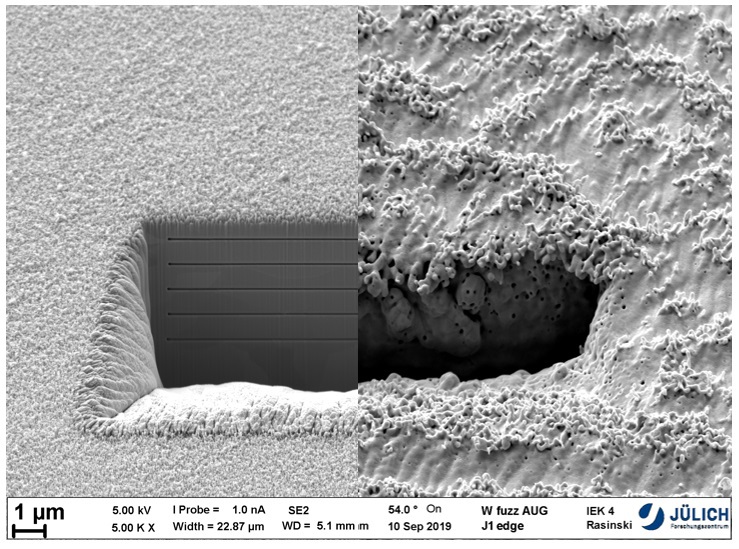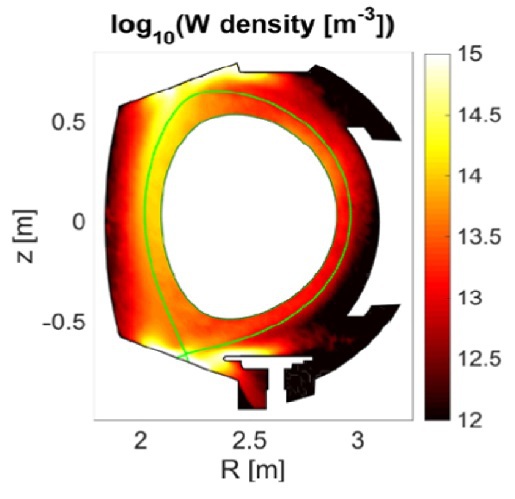Speaker
Description
The EUROfusion Work Package PFC (Plasma-Facing Components) focuses on critical plasma-surface interaction studies and components qualification in view of upcoming ITER operation and in preparation for DEMO exhaust solutions. This poster gives an overview of the latest main results in WP PFC, as well as their implications for ITER and DEMO.
Helium-Tungsten Interaction
The Helium-Tungsten (He-W) interaction was studied extensively in the full W tokamak WEST (CEA), in dedicated experiments in the divertor manipulator of ASDEX Upgrade with He pre-damaged W (MPG), in dedicated high fluence experiments on ITER monoblocks in the MAGNUM-PSI device (DIFFER), and compared with other laboratory studies and first principle modelling. The goal is the predictability towards He-W interaction in the different phases of ITER (He plasmas and DT plasmas with He ash). Figure 1 shows an example of the formation of W fuzz in samples exposed to ASDEX Upgrade H-mode plasmas. The results, showing pronounced evolution of the surface morphology and the creation of He nanobubbles below the surface, will be used to benchmark models relevant for lifetime estimations of the first ITER divertor. This work related to He-W interaction is done jointly with the ITER Organisation.

Fig.1) Formation of W fuzz in AUG [Brezinsek et al.]
Tungsten surface morphology and erosion
The erosion yield of the W fuzz has not only been studied under tokamak conditions, but also in laboratory arrangements with monoenergetic ion beam bombardment. These experiments provide the sputtering yield of 3D structured surfaces, as well as W fuzz, as a function of impact energy and impact angle. Complementary simulations of the surface evolution of e.g. W fuzz was performed with the TRI3DYN code. The reference binary-collision approximation code 3DTRIMSP has been benchmarked in 2018 against ion beam experiments and 3D structures and provides the input basis for larger scale modelling with ERO2.0 and WallDYN 3D. Overall, the combination of these laboratory and tokamak experiments will be used to benchmark also global migration codes with novel surface roughness modules (e.g. in ERO2.0).

Fig. 2) Preferential sputtering direction at rough surfaces [Eksaeva et al.]
Fig. 2 shows an example of the so-called needle formation under perpendicular impact on low-Z surfaces (Be), modelled with the roughness surface module implemented in ERO2.0. This example is an outcome of the long-standing PISCES-B cooperation between WP PFC and UCSD with regular guest scientists from EU send to the US to perform studies related to Be.
Finally, 3D modelling utilising the ERO2.0 code without the surface roughness module has been applied to benchmark JET (Be, W) and WEST (W) experiments as well as to predict the Be migration in ITER. A typical example from the WEST application is shown in fig. 3 providing the experimental plasma information, the plasma background as well as the corresponding ERO2.0 run. In the future, dedicated runs with the surface roughness of technical surfaces and appropriate material mixing will be done for the different devices in support of predictions for ITER and DEMO.

Fig. 3) ERO2.0 modelling of W erosion in WEST [Gallo et al.]
Qualification of ITER-like monoblocks
Tests of ITER-like monoblocks at elevated temperature were performed in high fluence experiments in MAGNUM-PSI, reaching record values of D+ fluence of 1031m-2, comparable to a year of ITER divertor operation without any visible damage and extremely low fuel retention. Re-crystallisation of W occurred in the high fluence experiments in D at the theoretically predicted material temperatures, which gives confidence in the lifetime predictions of the ITER divertor. Combined exposure of He and D ions in PSI-2 showed no impact on the recrystallization temperature, but on changes in the morphology. Additional emphasis was put on the study of monoblock castellation and shaping. ITER monoblocks with different shapings were installed in WEST for this purpose. The local damage of optical hot spots, which are predicted to occur in ITER at the projection of toroidal gaps, has been observed. Dedicated PIC modelling was applied and identified the particle and power flux to these locations. The same modelling was used for ITER predictions about castellation and shaping.
Parallel to these studies, ELM simulations by combined laser and plasma exposition and e-beam impact were carried out up to the record number of 106 ELM-like pulses, to study the response of W to repetitive transient heat loads. All three W PFC studies contribute to the determination of the operational window for the W divertor in ITER regarding heat loads, transients and surface temperature conditions.
Complementary, studies with plasma and high heat flux exposure on advanced materials such as PIM-W, WfW etc. - developed under WP MAT- started in WP PFC in 2019. Multiple disruption-like loads on W were carried out in the plasma gun facility QSPA in KIPT. The surface damage evolution was compared to previous studies on the ITER-grade reference W regarding synergistic effects with combined plasma and heat load.
Fuel retention
Finally, dedicated experiments were carried out to quantify the fuel retention in W for combined D and N2 exposure in laboratory and linear plasma conditions. A dramatic enhancement of the retention in the near-surface area has been identified, with local fuel content in the percentage range depending on the exposition conditions. WN formation has been observed near the surface, acting in some cases as permeation barrier. Thus, the actual enhancement in fuel retention is solely near the surface, which can interact during plasma operation with the recycling and fuelling of tokamak plasmas. The second system investigated regarding the fuel retention by implantation is the mixed He-D system in W in combination with neutron damage proxies. Self-damaging by W ions was applied to simulate defects in W and mimic the impact of fusion neutrons. Enhanced retention by the synergistic effects has been documented. Detailed modelling was applied to simulate the observed enhancement of retention in the near surface. The fuel release efficiency was documented by stepwise heating of the W material. Fuel recovery at high temperatures is challenging if He impact and neutron damage are present simultaneously.
In order to quantify in-situ or in-operando the retention of T and D in the first wall material of fusion devices, a dedicated task utilising LIBS and LIA-QMS was executed successfully in 2019 (see contribution of H. van der Meiden et al., “LIBS - monitoring of tritium and impurities in the first wall of fusion devices”). The experiments demonstrated the capability to resolve D and T as well as quantify the fuel in different types of ITER-like codeposits containing in particular Be and W as well as impurities as found in JET samples.
Bibliography
S. Brezinsek et al., PSI 2020, Jeju, Korea
A Eksaeva et al. PSI 2020, Jeju, Korea
A Gallo et al., 2020 Phys. Scr.2020 014013
| Affiliation | Forschungszentrum Jülich GmbH / EUROfusion |
|---|---|
| Country or International Organization | Germany |
